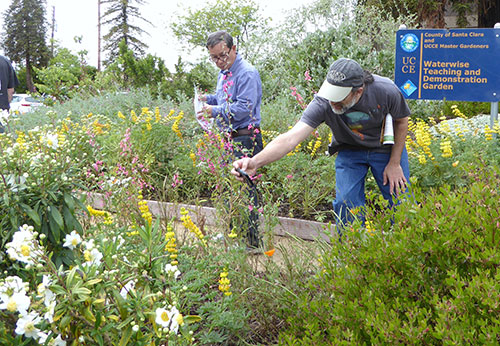The Santa Clara County and University of California Cooperative Extension (UCCE) Master Gardeners Waterwise Teaching and Demonstration Garden was vibrant with spring-blooming, native California bushes and flowers for Santa Clara Valley’s 15th annual Going Native Garden Tour on April 22 and 23.
Traditional lacy, white yarrow was planted next to its hybrid cousin, paprika red yarrow. Milkweed was planted to attract Monarch butterflies. Orange sticky monkey flowers and California poppies were scattered like bright flashes of wildfire.
All competed for the attention of visitors to the four-year-old, 3,000-square-foot demonstration garden–1553 Berger Dr. (in front of building 1), San Jose. But it was the bushy carpenteria, covered with masses of white flowers, and chick lupine bushes with stems of sunshine-yellow flowers that first caught the eye on the sunny spring Saturday.
“Not all wildflowers are California wildflowers. Be cautious of where you purchase your wildflower seed. Be sure it’s California wildflower seed,” advised UCCE demo garden designer and master gardener Rebecca Schoenenberger (www.calnativescapes.com), leading a tour of the garden, which showcases UC Davis Arboretum all-stars tested by the arboretum.
The all-stars are 100 plants identified by the arboretum as being tough, reliable, easy to grow and having low water requirements and few pest or disease problems. Many are California natives (www.arboretum.ucdavis.edu/arboretum_all_stars.aspx).
“If a plant can survive in Davis, it’s pretty hardy,” said Schoenenberger. “They don’t need to be watered every day. The first year, water deeply two or three times a week. Water out where the roots are, not at the stem.”
Schoenenberger showed note-taking garden visitors the nine-volt battery-operated, in-line drip system that was in place for deep soaks. Its tubes were buried under a three-inch layer of wood chip mulch. She advised that the ideal time to plant is in the fall when plants might get the most rain and the days are shorter and not as hot.
“Remember, at first plants sleep. Then they creep. Then they leap,” Schoenenberger said. “It takes time to get roots happy before they’ll get happy on the top.”
“Plants are awesome. They’re very expressive,” said San Jose resident Erik Acosta, a demonstration garden volunteer and a master gardener-in-training. “They define the landscape and make it stand out.”
“You have to group plants by their needs and think ahead. Plant to the future,” said Acosta, pointing out that it’s important to know what the mature size of a plant will be.
Master gardener Sue Eakins from San Jose explained that the mission of Santa Clara County’s Master Gardener program is to educate urban gardeners about the best practices using research-based information. The best practice, for example, for integrated pest management is first to use ways that do the least harm to the environment. And don’t stir up weed seeds by rototilling.
Master gardener volunteers are available by phone to give advice Monday through Friday, 9:30 a.m. to 12:30 p.m. at (408) 282-3105. E-mail questions to mgsantaclara@yahoo.com. For integrated pest management information, visit www.ipm.ucdavis.edu.
More than 50 gardens were on display from Woodside and San Mateo to Alviso and Gilroy for the weekend Going Native Garden Tour. The 40-acre Ulistac Natural Area (www.ulistac.org), 4901 Lick Mill Blvd., was the sole tour destination in Santa Clara.
“Being in a garden, observing, working, nurturing, you begin to see insects and birds and bees and the interaction–all the natural things that happen–and that leads to more interest in gardening,” said Eakins. “A garden provides so much. It’s almost like meditation. It’s stress relief.”
